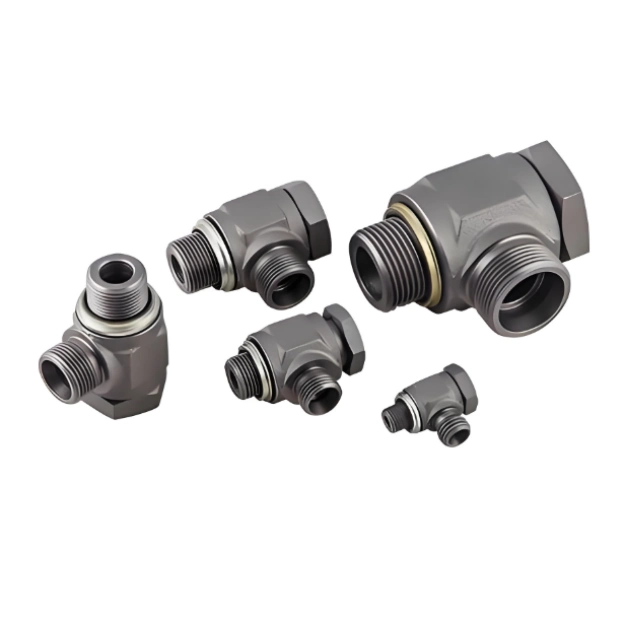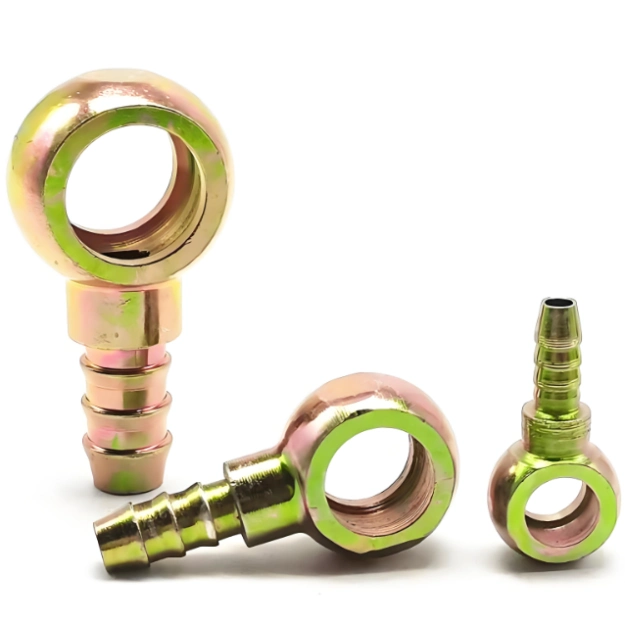Hydraulic Banjo Fittings are compact rotary joints used to connect lines, blocks or actuators in hydraulic systems. It gets its name from its unique shape that resembles the musical instrument “Banjo”. They are particularly suitable for applications where space is limited or where an angled connection is required. The following is a detailed explanation of how they work, how they seal and how they are installed:
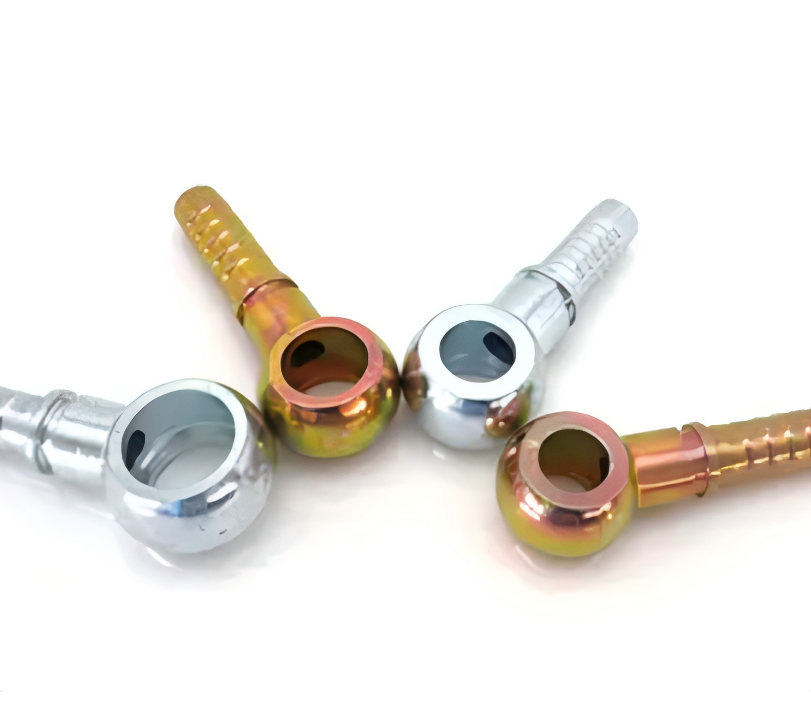
How Banjo Fittings Work
Banjo fittings core structure:
Banjo body: the main body is a hollow ring structure (like a ring) with through holes on both sides. The cavity in the center is the channel through which the hydraulic fluid flows.
Bolt: A special hollow bolt passes through a hole in the center of the banjo body. The bolt’s center hole is the main channel for hydraulic fluid .
Interface:
One end: usually a threaded connection to a hose or hard pipe (e.g. BSPP, BSPT, NPT, JIC, Metric, etc.).
The other end: is the head of a bolt with a sealing surface that is pressed against a port on a valve block, pump, motor or other component.
Oil flow path:
Hydraulic fluid enters the ported end of the banjo body from a connected hose/hard pipe.
Oil flows into and fills the annular cavity inside the banjo body.
The fluid flows out through the hole in the center of the hollow bolt.
The oil finally flows from the outlet in the head of the bolt to the target component (e.g. valve block port).
Key Banjo Fitting Features Rotation:
The banjo body is free to rotate 360 degrees around the hollow bolt.
This allows connected hoses or rigid tubing to be adjusted to the optimum position after installation, avoiding twisting, reducing stress, and facilitating plumbing and maintenance.
The rotation occurs between the banjo body and the bolt, with the interface end (connecting line) and the head of the bolt (connecting port) being the fixed connection points.
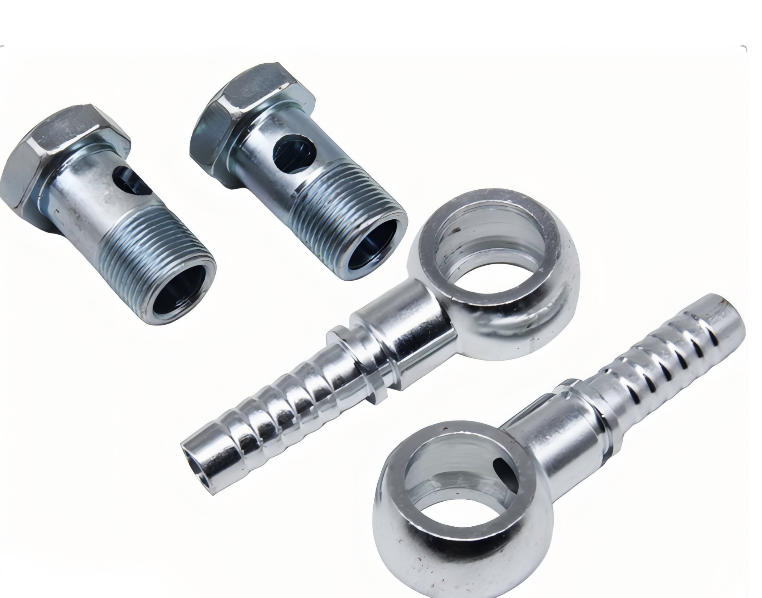
Banjo fitting sealing method :
Sealing is the key to preventing hydraulic fluid leakage. Banjo fittings have two main critical sealing points :
The seal between the sealing surface of the head of the bolt and the port of the element (primary seal):
Seal Type: Face Seal / Flange Seal: This is the most common and reliable method. The head of the bolt has a smooth, flat, annular end face (flange face). This face is pressed against the smooth, flat sealing surface corresponding to the port of the target element by tightening the bolt.
Sealing element: Between the two flat surfaces, an elastic sealing ring must be placed to realize the seal.
Commonly used seal types:
O-Ring: Most commonly placed in the O-Ring groove of the connected element (SAE/JIS standard ports) or in the O-Ring groove of the head of a hollow bolt (DIN standard bolt).
Metal washers/composite washers: Sometimes used for high pressure or special applications (e.g. some metric ports), the washer is pressed between two flat surfaces.
Sealing principle: By tightening the bolt enough axial compression force is generated to cause elastic deformation of the elastic sealing ring (O-ring) in the plane, filling the microscopic unevenness and forming a reliable static seal.
Seal between banjo body and hollow bolt (secondary/rotary seal):
Seal Form: Usually relies on precision machined mating surfaces and/or O-rings.
Sealing Element: Metal Seal: The inner bore of the banjo body and the outer diameter of the hollow bolt are precision machined (ground) to form a very tight clearance fit. The primary function is to guide and limit significant oil leakage, but may not be sufficient to completely seal at high pressures.
O-Ring Seal (common): A groove designed to fit an O-ring in the axial or radial location where the banjo body fits into the hollow bolt is the more common way to ensure a reliable seal in this area.
Sealing Principle: The O-ring is compressed into the groove, creating a radial or axial seal.
Precision fit: Reduces the leakage path and supports the O-ring, if used. The sealing pressure at this point is usually lower than at the main sealing point.
How to install banjo fittings :
Proper installation is critical to ensure seal reliability and system safety:
Preparation for Banjo Fitting Installation:
CLEANING: Thoroughly clean all parts (banjo body, hollow bolts, seals/O-rings) and ports and threads of connected components. Any dirt, debris or old sealing material can cause leaks.
INSPECTION: Inspect all parts for damage, burrs, scratches or deformation. Replace damaged parts, especially seals.
Lubrication: Apply a small amount of clean hydraulic fluid to the seal (O-ring) . This aids in installation, prevents twisting or cutting of the seal, and provides initial lubrication upon startup. Avoid using grease unless compatible grease is specifically specified by the system manufacturer.
Banjo Accessories Installation of Seals:
- carefully install the correct new seal (usually an O-ring) into the designated groove.
- Ensure that the O-ring is not twisted, overstretched or pushed out of the groove. For flat seals, the O-ring should be in the groove of the port or bolt head.
- Assemble the banjo body and hollow bolt:
Thread the hollow bolt through the center hole of the banjo body. Normally, the banjo body should rotate smoothly on the bolt. If an o-ring is used on this part (on the banjo body), make sure it is properly installed.
- Positioning and Initial Connection:
Align the head of the bolt of the assembled banjo fitting (bolt + banjo body) with the port of the target element.
Gently screw the hollow bolt into the port threads by hand a few turns to ensure that the threads are properly engaged and there are no misclips. Do not tighten hard at first!
- Rotate to adjust:
With the bolt not yet tightened, freely rotate the banjo body , so that the port end (the end to which the line is attached) is facing the desired direction. Ensure that the connected hose or hard pipe can be routed smoothly, without twisting or tension. Adjust to the optimum position.
- Final tightening:
Once the banjo body is oriented, using a suitable torque wrench , tighten the hollow bolts to the recommended torque values provided by the manufacturer.
Key:
Always use a torque wrench! Over-tightening can crush the O-ring and damage the sealing surface or threads; over-tightening can cause leaks.
Tighten the bolts, not the banjo body! Keep the banjo body from rotating during tightening (a wrench can be used to gently hold the banjo body interface in place, but only apply the minimal force needed to prevent rotation) to ensure that its orientation remains the same. The main tightening torque is applied to the hollow bolt.
Follow the principle of cross-tightening (if more than one banjo bolt is used to connect the flanges), tightening evenly in steps.
- Connect the piping:
Screw the hose fitting or hard pipe into the threads on the interface end of the banjo body. Again, tighten the line fitting using the correct torque.
Ensure that the line connection does not apply excessive bending or torsional stress to the banjo fitting.
- Inspection:
Visually check that the installation is in place and correctly oriented.
Perform a system pressure test to check for leaks in the banjo fitting (especially at the head of the bolt and at the banjo body/bolt rotation). If there are leaks, the installation and seals must be rechecked after relieving pressure.
Banjo Fitting Sizing Parameters
Banjo fitting sizes are specific to their type, standard, application pressure and flow requirements. There is no single “all sizes” list, but they can be categorized and understood based on key parameters:
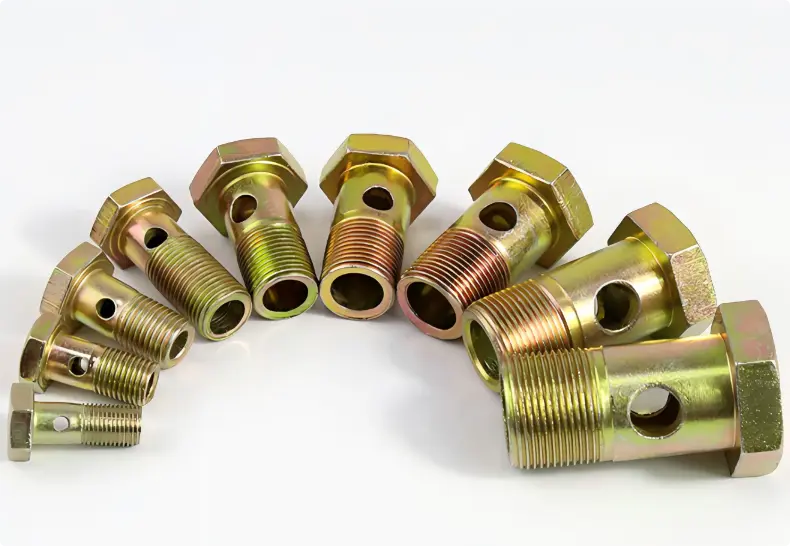
Banjo Fitting Port Size.
This is the size of the threaded or flanged port on a fitting that is used to connect a hose, pipe, or other fitting.
Most common standard:
Metric Thread: e.g. M10x1, M12x1.5, M14x1.5, M16x1.5, M18x1.5, M20x1.5, M22x1.5, M24x1.5, M27x2, M30x2, M33x2, M36x2, M42x2, M48x2 etc.
Imperial Thread BSPP / BSPT.
BSPP (G): G1/8, G1/4, G3/8, G1/2, G5/8, G3/4, G1, G1 1/4, G1 1/2, G2, etc.
BSPT (R/Rp): R1/8, R1/4, R3/8, R1/2, R3/4, R1, etc.
NPT / NPTF: 1/8 NPT, 1/4 NPT, 3/8 NPT, 1/2 NPT, 3/4 NPT, 1 NPT, 1 1/4 NPT, 1 1/2 NPT, 2 NPT, etc.
SAE Straight Thread ORB: Common sizes are 4 (7/16 20), 5 (1/2 20), 6 (9/16 18), 8 (3/4 16), 10 (7/8 14), 12 (1 1/16 12), 16 (1 5/16 12), 20 (1 5/8 12), etc. These are usually used with O-Ring seals. These are usually paired with o-ring seals.
Number of Ports: Banjo fittings can be single ported (connected at one end), double ported (T-shape, tee), or multi-ported (block). Port sizes can be the same or different.
Mounting Flange Size / Bolt Hole Pattern.
This is the origin of the name “banjo” and refers to the flange portion of the fitting that secures to the flat surface of the block, cylinder, pump, or other component.
Key dimensions include:
Bolt Circle Diameter BCD: The diameter of the circle formed by the centers of two or more mounting bolt holes. Examples: Ø25mm, Ø32mm, Ø40mm, 1“, 1.25”, 1.5”, etc.
Number of bolt holes: 2 holes is the most common, 4 holes or other forms are also available.
Bolt hole diameter: M5, M6, M8, M10, 1/4“, 5/16”, 3/8” etc.
Flange Thickness/Height: The overall thickness or mounting height of the fitting.
Flange OD/Profile Size: The outside dimensions of the flange.
Banjo Fitting Angle (Angle).
The most common banjo elbow is 90 degrees.
There are also variants with 45 degrees, 30 degrees, or other specific angles.
Straight-through models have no angle of bend, only a flange mounting surface.
Banjo Fitting Sealing Type.
This directly affects the size and design of the port:
O Ring Boss ORB: Fits SAE straight threads with a groove in the root of the thread to place an O-ring, sealing against a flat surface.
Face Seal / Flat Seat / Flareless: Port face is flat, usually with grooves for O-Rings or gaskets (e.g. DKO, DKOL, Metric Flat Seat).
Cone Seal: e.g. 24° cone (DIN / Metric) for metric systems.
Spherical Seal: e.g. BSPP (G) threads usually with copper or composite washers.
Tapered Thread Seal: e.g. BSPT (R) and NPT/NPTF, relies on the taper of the thread to seal (usually requires a sealant).
O-rings or gaskets are typically used to seal between the flange face of the banjo and the mounting surface.
Common Applications and Typical Size Ranges for Banjo Fittings
Industrial hydraulics: A wide range of port sizes is common, from small M10x1 / G1/8 to large M42x2 / G2. Mounting flanges BCD are typically in the range of Ø20mm to Ø50mm and M5, M6, M8 bolts are commonly used.
Construction Machinery/Mobile Hydraulics: More commonly used are inch or US sizes such as 1/4 NPT, 3/8 NPT, 1/2 NPT, 6 ORB, 8 ORB, and G1/4, G3/8, G1/2. Flange sizes also tend to be in the inch range, BCD such as 1“, 1.25”, 1.5“, etc., with bolt holes such as 1/4” 20, 5/16” 18.
Compact applications/block adapters: Small banjos (e.g. M10x1, G1/8, 1/4 NPT) with small flanges (BCD Ø20 25mm, M5 bolts) are commonly used.
High pressure applications: more robust designs and larger bolts are required and sizes will increase accordingly.
How to determine the exact size?
- Measure existing fittings:
Ports: accurately measure the large diameter and pitch of the threads (with a thread gauge), determine the type of thread (metric/imperial/taper), and observe the form of sealing on the end face of the ports (flat surface/O-ring groove/taper).
Installation flange: Measure the distance between the centers of the two bolt holes (BCD), measure the diameter of the bolt holes, count the number of bolt holes, measure the flange thickness and outer contour dimensions.
Angle: Measure the angle of the elbow (usually 90°). - Check the equipment manual or parts drawing: the manufacturer usually indicates the interface dimensions.
- Inform the supplier of the application scenario: state what equipment it is used in (e.g. excavator cylinders, injection molding machine valve blocks), the pressure rating, and the type of components to be connected (hose fitting type, valve block interface standard), which the supplier can recommend based on experience.
- Use samples or selection software: the major hydraulic couplings suppliers (such as Parker Parker, Eaton Eaton, Yonghua couplings, etc.) have a detailed product catalog and online selection tool, you can filter according to the size parameters.
Size Selection Considerations:
Hydraulic banjo fittings come in an extremely wide range of sizes, and the core is to determine:
Port size and standard (including thread type, size, sealing method)
Mounting flange size (BCD, bolt hole diameter and number)
Angle (90°, 45°, straight through, etc.)
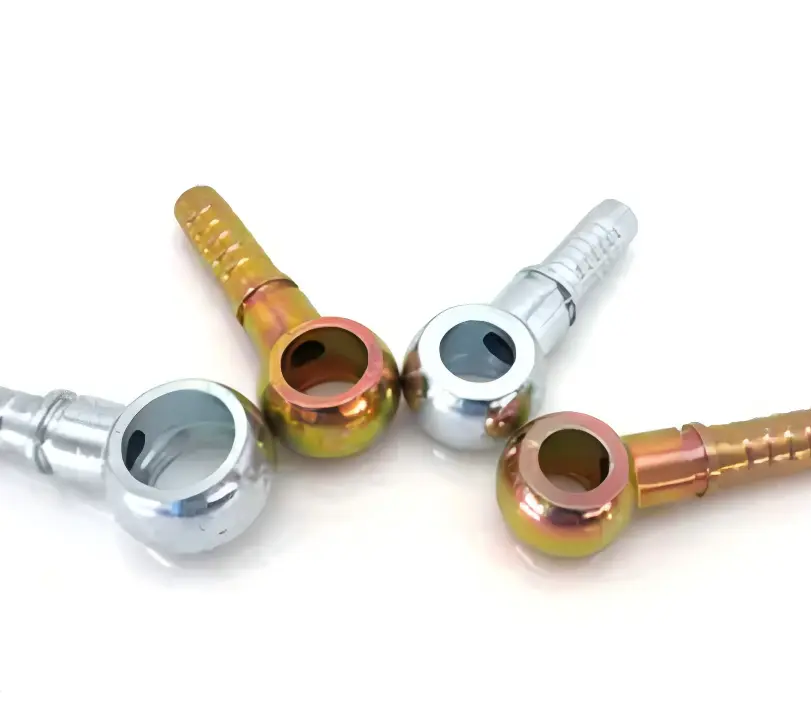
Summarize the key points:
Principle: through the hollow bolt infusion, banjo body ring cavity distribution of oil, the core advantage is the interface end can be rotated 360 degrees.
Sealing: Two key points. Primary seal (bolt head to port) relies on flat surfaces + O-rings (most common); secondary seal (banjo body to bolt) relies on precision fit and/or O-rings.
Installation: clean, lubricate o-rings, assemble correctly, hand-turn to threads, adjust orientation, torque wrench to tighten bolts (to secure banjo body orientation), connect lines, pressure test.
Sizing:
Hydraulic banjo fittings come in a wide variety of sizes, and the heart of the matter is determining:
Port size and standard (including thread type, size, sealing method)
Mounting flange dimensions (BCD, bolt hole diameter and number)
Angle (90°, 45°, straight through, etc.)
SAFETY WARNING: Always install or service a system after it has been completely relieved of pressure. Strictly follow the torque specifications and installation instructions provided by the manufacturer. Incorrect installation can result in leakage of high pressure oil, causing serious personal injury or equipment damage.

